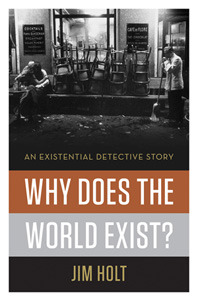More on this book
Community
Kindle Notes & Highlights
by
Jim Holt
Read between
February 12 - February 21, 2023
if there were nothing, nothing would be forbidden. Thus nothing is self-forbidding.
“When I invented the theory of chaotic inflation, I found that the only thing you needed to get a universe like ours started is a hundred-thousandth of a gram of matter,”
Of course, orthodox believers can always respond to a scenario like Linde’s by saying, “Okay, but who created the physicist hacker?” Let’s hope it’s not hackers all the way up.
The crux of the mystery of existence, as I have said, is summed up in the question Why is there something rather than nothing? William James called this question “the darkest in all philosophy.” The British astrophysicist Sir Bernard Lovell observed that pondering it could “tear the individual’s mind asunder.” (Indeed, psychiatric patients have been known to be obsessed by it.)
it is strange that nobody explicitly asked, Why is there something rather than nothing? until the modern era. Perhaps it’s the “nothing” part of the question that makes it truly modern. Premodern cultures have their creation myths to explain the origin of the universe, but such myths never start from sheer nothingness. They always presuppose some primordial beings or stuff out of which reality arose.
The “pessimists” believe that there might be a reason for the world’s existence, but that we’ll never know for sure—perhaps because we see too little of reality to be aware of the reason behind it,
In 1921, a New York rabbi asked Einstein if he believed in God. “I believe in Spinoza’s God,” he answered, “who reveals himself in the orderly harmony of what exists, not in a God who concerns himself with the fates and actions of human beings.”
0 = 1–1 What might it represent? That 1 and –1 add up to zero, of course. But that is interesting. Picture the reverse of the process: not 1 and –1 coming together to make 0, but 0 peeling apart, as it were, into 1 and –1. Where once you had Nothing, now you have two Somethings! Opposites of some kind, evidently. Positive and negative energy. Matter and antimatter. Yin and yang.
In the absence of time, –1 and 1 cancel; they coalesce into zero. Time allows the two opposites to peel apart—and it is this peeling apart that, in turn, marks the emergence of time. It was thus, Atkins proposes, that the spontaneous creation of the universe got under way.
If nothing is an annihilating force, Nozick conjectured, it might just “noth” itself, thereby giving rise to a world of being. He imagined nothing as “a vacuum force, sucking things into non-existence or keeping them there. If this force acts upon itself, it sucks nothingness into nothingness, producing something or, perhaps, everything.”
philosopher’s fallacy: a tendency to mistake a failure of the imagination for an insight into the way reality has to be.
Nothingness = a closed spherical spacetime of zero radius
Now, suppose you try to remove every bit of energy from a region of space. Suppose, in other words, you try to reduce that region to its state of lowest energy, which is known as its “vacuum state.” At a certain point in this energy-draining process, something very counterintuitive will occur. An entity that physicists call the “Higgs field” will spontaneously emerge. And this Higgs field cannot be got rid of, because its contribution to the total energy of the space you are trying to empty out is actually negative. The Higgs field is a “something” that contains less energy than a “nothing.”
...more
Perhaps the absence of one thing, in either imagination or reality, always entails the presence of another. Delete George Bailey from the scheme of things and up pops Pottersville.
The Big Bang—the physical transition from nothing to something—was not only inconceivably violent, but also inherently lawless. Physics tells us that there is in principle no way of predicting what might pop out of a naked singularity. Not even God could know.


